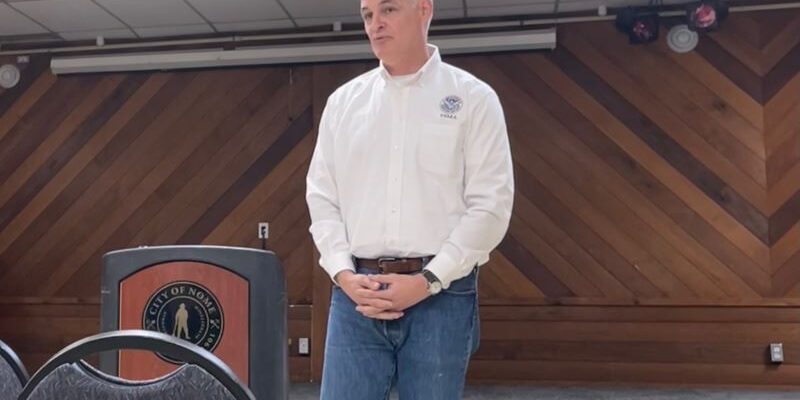This story was reported and written by KNOM reporter Ava White.
The Alaska Division of Homeland Security and Emergency Management and the Federal Emergency Management Agency gathered at the Mini Convention Center in Nome, Friday, June 23, for a post-Typhoon Merbok meeting.
Individuals were encouraged to attend to ask questions, hear updates and find out more information regarding individual and public assistance plans to recover from damages. DHSE and FEMA announced that financial assistance is still available, despite the application closing in February.
Brian Fisher, the director of DHSE, describes more damages were found on properties after the snow melted.
“We assumed and we knew that folks may have discovered additional damages either at their subsistence camps or at their primary residences, once the snow melted this winter,” Fisher said. “We’re here to make sure that people understand they can come back to FEMA, come back to the state, and identify those damages that they might not have seen in the fall, and potentially receive more assistance.”
More than $1.8 million was distributed after Gov. Mike Dunleavy issued a disaster declaration, which activated the state individual assistance program in 2022/23. While the application closed in February, programs are available for those who were unable to access their properties or receive financial assistance after the typhoon.
Duke Davis, the federal coordinating officer of FEMA, says about 1,200 FEMA assistance applications were filed and $6.8 million was distributed. Davis adds that FEMA is now trying to learn what assistance rural communities still need.
“We have eight or 10 folks on the ground that are following up now and going out into communities and having a discussion with them,” Davis said. “We’ve gone through with the Individual Assistance Program, and now the public assistance program as well, are there other unmet needs out there in the community that are not being covered by these two programs.”
Typhoon Merbok caused severe damages to several communities of western Alaska, totaling to over 1,200 miles of coastline across 35 communities. Many families lost their camps, houses and materials. The typhoon was the region’s strongest storm in more than half a century.
Fisher says the state is now dealing with massive amounts of lost coastline.
“Up and down the entire coast, from Southwest all the way up to Northwest, we’ve seen some pretty dramatic coastal changes, a lot more permafrost is exposed now,” Fisher said. “And that’s just going to cause even more rapid degradation and melting of the permafrost because of the effects of the typhoon that hit us. So we’re gonna see changes from those for years and years to come.”
The deadline for FEMA applications closed in February. Those who wish to appeal FEMA decisions are able to do so within a 60-day period. If it is past the 60-day period, those who appeal must explain the reason for delay.
The U.S Department of Agriculture is offering up to $40,000 to homeowners affected by a disaster. There is no deadline to apply. Program qualification and terms can be found on the USDA website.
Native Movement is providing one-time grants of $500 per qualifying household impacted by Typhoon Merbok. Eligibility requirements can be found online at nativemovement.org.
Kawerak’s Land Management Services is assisting in defining and marking land boundaries.
Fisher says, having an emergency preparedness kit is an important step in preparing and protecting your household.
“It’d be good to have three days of supplies on hand for every member of your household, it’d be better to have a week of supplies and it really would be best to have many more days of supplies,” Fisher said.
Fisher adds that, if possible, emergency kits should contain enough supplies for 14 days.
Image at top: Duke Davis of FEMA answers questions at the town hall meeting on Friday, June 23. Photo by Ava White/KNOM




